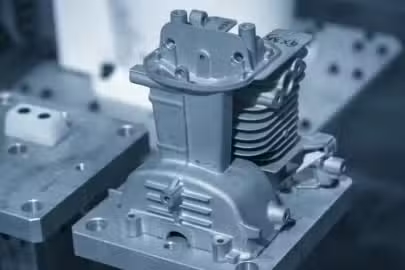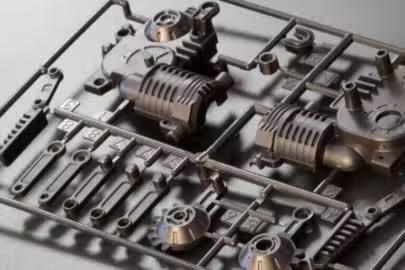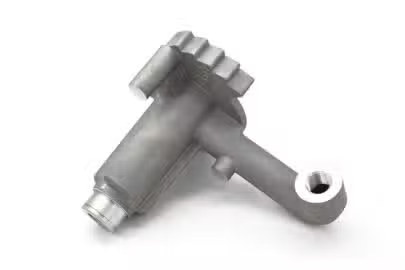When it comes to creating prototypes quickly and efficiently, the choice of manufacturing method plays a crucial role. Sand casting, with its flexibility and cost-effectiveness, has emerged as a viable option for rapid prototyping in various industries.
This article explores whether sand casting is a good fit for rapid prototyping by examining its process, applications, surface finishes, and the advantages it offers. We’ll also delve into why sand casting is suitable for rapid prototyping and how it compares to other methods.
Overview of Sand Casting

Sand casting is one of the oldest and most versatile metal casting techniques. It involves creating a mould from a mixture of sand and a binding agent, which is then used to shape molten metal into a desired form. This process is particularly advantageous for producing intricate and complex geometries without requiring expensive equipment or long lead times. Sand casting is used to create both small parts and large components, making it suitable for a wide range of applications.
How it Works
The sand casting process begins with creating a pattern, typically made of wood, metal, or plastic, which serves as a replica of the final component. The pattern is placed in a moulding box and surrounded by sand, which is compacted to form a solid mould. Once the mould is formed, the pattern is removed, leaving a cavity in the shape of the desired part. Molten metal is then poured into the cavity and allowed to cool and solidify. After solidification, the sand mould is broken apart to reveal the cast component. The final piece may require additional machining or finishing, depending on its intended use.
Applications
Sand casting is widely used in industries such as automotive, aerospace, construction, and marine engineering. It is ideal for producing engine blocks, housings, brackets, pump casings, and large industrial parts. Because it can accommodate a variety of metals, including aluminum, iron, and steel, sand casting is highly versatile in meeting diverse project requirements. Its ability to create complex shapes and accommodate various materials makes it suitable for both prototype development and production runs.
Surface Finishes
The surface finish of sand cast parts depends on several factors, including the type of sand used, the casting process parameters, and the complexity of the design. While sand casting typically results in a rougher surface finish compared to other casting methods, this can be improved with post-processing techniques like machining, grinding, or polishing. Achieving a smooth surface may require additional finishing steps, but for many applications, the as-cast finish is acceptable, particularly for prototypes where surface aesthetics are not the primary concern.
Is Sand Casting a Good Fit for Rapid Prototyping?
Yes, sand casting is a suitable method for rapid prototyping, especially for components that need to be produced quickly, cost-effectively, and in small quantities. Its low upfront costs, fast mould preparation, and adaptability to changes make it a good choice for prototyping when compared to other casting methods or machining processes.
With sand casting, engineers and designers can test different geometries, materials, and design features without the need for high-cost tooling or moulds, which is often a constraint in other manufacturing techniques like die casting or injection moulding.
Why Sand Casting is a Good Fit for Rapid Prototyping?
Several factors make sand casting a viable option for rapid prototyping, particularly in the early stages of product development:
Cost-Effectiveness
Sand casting does not require expensive tooling or moulds, making it a cost-effective option for creating prototypes. The use of sand as the moulding material also reduces expenses compared to metal moulds used in other casting techniques. This cost efficiency is particularly advantageous for small-scale projects or when developing a limited number of prototypes.
It allows companies to produce initial prototypes without incurring the high costs typically associated with other processes, such as high pressure die casting or CNC machining. Moreover, any changes to the design can be easily implemented with minimal impact on overall expenses, ensuring that the project remains within budget.
Flexibility in Design Changes
Sand casting allows for quick modifications to the mould without the need for extensive retooling. This flexibility is particularly beneficial for rapid prototyping, where design iterations and changes are common. Engineers can easily make adjustments to the pattern or mould to accommodate new design features or requirements.
This adaptability makes sand casting ideal for testing various designs and geometries, making it easier to find the most optimal solution before committing to large-scale production. Additionally, engineers can use different pattern materials, such as wood or foam, to make modifications more efficiently, enhancing the overall flexibility of the process.
Ability to Produce Complex Geometries
The sand casting process is capable of producing complex shapes and geometries that might be challenging or expensive to achieve using other manufacturing methods. This is crucial in prototyping, where testing different design features and geometries is often necessary to optimize the final product.
Sand casting supports the creation of intricate internal structures, undercuts, and varying wall thicknesses, which are essential for components like engine blocks or fluid flow systems. The process also allows for the integration of cores, enabling the production of hollow sections or cavities that are difficult to achieve with traditional machining.
Suitable for Various Metal Types
Sand casting supports a wide range of metals, including aluminum, iron, steel, and bronze. This versatility allows engineers to test the performance of different materials in a prototype before deciding on the most suitable option for production.
The ability to experiment with different materials provides valuable insights into properties like strength, corrosion resistance, and thermal conductivity. By assessing how different alloys perform in a prototype, engineers can make informed decisions about which material to use in the final product, ensuring optimal performance and durability.
Fast Turnaround Time
Compared to other casting methods, sand casting offers a relatively fast turnaround time, as the moulds can be quickly prepared and modified. This speed is essential for prototyping projects that operate on tight schedules. Rapid turnaround times allow for the efficient testing and validation of design concepts, helping businesses bring their products to market faster.
Even for complex designs, the time to produce a working prototype is significantly reduced, as mould creation and casting can be completed within days, not weeks. This ensures that project timelines are adhered to, preventing delays in the development process.
No Size Limitations
Sand casting can produce both small and large components, which makes it suitable for prototyping large parts like engine blocks or smaller components like housings and fittings. This flexibility in part size ensures that the process can cater to various project needs.
Large components that would be difficult to produce using other methods can be cast in sand moulds, providing a solution for industries that require substantial structural or mechanical parts. This adaptability in size further underscores sand casting’s viability as a rapid prototyping solution across multiple industries, including automotive, aerospace, and heavy machinery.
Environmental Sustainability
Sand casting is relatively environmentally friendly compared to other methods. The sand used in the process can often be recycled and reused, reducing waste and the environmental impact of the prototyping process. The reusability of sand contributes to lower material costs and reduces the consumption of raw materials.
Furthermore, many foundries are adopting more sustainable practices by implementing waste recovery systems and using eco-friendly binders in sand moulds. This commitment to sustainability aligns with modern industry trends towards greener manufacturing processes, making sand casting an appealing choice for companies focused on reducing their environmental footprint.
Limitations and Challenges of Sand Casting for Rapid Prototyping

While sand casting offers numerous advantages for rapid prototyping, it’s not without its limitations and challenges. Understanding these drawbacks helps businesses make informed decisions on whether sand casting is the best choice for their specific prototyping needs or if other methods like CNC machining or die casting would be more appropriate. Below, we explore the main limitations and challenges associated with using sand casting for rapid prototyping.
Surface Finish Quality
One of the most significant drawbacks of sand casting is the surface finish quality. The nature of sand moulds often results in rougher surface textures compared to other casting or manufacturing methods, such as die casting or CNC machining. This coarse finish may require additional post-processing like grinding, polishing, or machining to achieve the desired surface smoothness. Such post-processing can increase both the lead time and cost of the prototype, especially when fine finishes are critical to the design. For applications that demand precise and smooth surfaces, alternative methods may be more suitable despite sand casting’s cost benefits.
Dimensional Accuracy and Tolerance
Sand casting generally provides lower dimensional accuracy and tolerances compared to other manufacturing methods like die casting or CNC machining. The sand mould can shift slightly during the casting process, causing minor variations in the final dimensions of the prototype. For prototypes where high precision and tight tolerances are necessary, these variations can be problematic and may lead to design flaws or performance issues. Engineers may need to compensate for these potential discrepancies by oversizing certain features and relying on additional machining or finishing processes to bring the prototype within the required specifications.
Limited Material Strength
The sand casting process can sometimes result in parts with less uniform material properties and internal defects like porosity or shrinkage cavities. This can reduce the overall strength of the cast component, making it less suitable for applications requiring high load-bearing capabilities or mechanical durability. While these limitations are not always critical during the prototyping stage, they can affect the prototype’s performance during testing and evaluation, leading to misleading results. If testing under real-world conditions is a key objective, other prototyping methods like CNC machining, which offer superior material strength and consistency, might be more appropriate.
Complexity of Fine Details and Thin Walls
While sand casting is excellent for producing complex shapes, it struggles with fine details and very thin walls. The granular nature of the sand used in the mould makes it challenging to reproduce intricate patterns or fine features. Moreover, creating thin-walled sections can be problematic due to the tendency of molten metal to cool and solidify unevenly, causing warping or incomplete filling of the mould. This makes sand casting less suitable for prototypes that require detailed features, fine patterns, or thin sections, which might be better achieved with other casting techniques like high pressure die casting.
Potential for Defects and Inconsistencies
Sand casting is prone to certain defects and inconsistencies, such as porosity, inclusions, or sand-related imperfections like blowholes and surface scabs. These defects can arise due to issues like improper mould preparation, incorrect pouring temperatures, or inadequate venting. For rapid prototyping, where multiple design iterations might be necessary, these defects can disrupt the prototyping process and lead to delays. Defects might also complicate the evaluation of the prototype’s functionality, especially if the defects are not immediately apparent but affect the part’s performance during testing.
Labour and Expertise Requirements
Despite being a relatively simple process, sand casting requires skilled labour for optimal results. Proper mould preparation, metal pouring, and post-casting processing all depend on the expertise of the operator. Inconsistent results can arise when there is a lack of experience or precision in handling these steps. For businesses without in-house expertise, outsourcing sand casting can be a viable solution, but it may also introduce additional costs and coordination challenges, especially for quick-turnaround prototyping projects.
Environmental and Safety Considerations
Sand casting involves handling molten metal at high temperatures, which presents safety risks and potential environmental concerns. The process can release fumes and emissions depending on the type of sand, binders, and alloys used. While sand is generally a recyclable material, other components, like certain binder chemicals, may have environmental implications if not managed properly. Ensuring safe and environmentally compliant sand casting operations may require additional equipment, training, or facilities, adding complexity to the prototyping process.
Conclusion
Sand casting is an excellent choice for rapid prototyping due to its flexibility, cost-efficiency, and ability to produce complex shapes and large parts quickly. While it may not provide the smoothest surface finish, its speed and adaptability make it ideal for testing materials and geometries before mass production.
Zintilon offers expert sand casting services tailored to specific project needs, ensuring high-quality results for both single prototypes and small production runs. With years of experience and advanced technology, Zintilon delivers precise, reliable casting solutions that accelerate product development and meet the highest quality standards.
Great, Together



